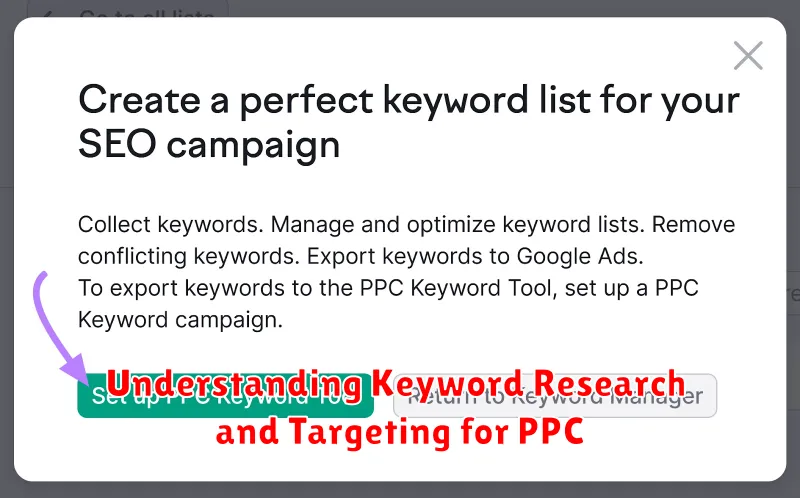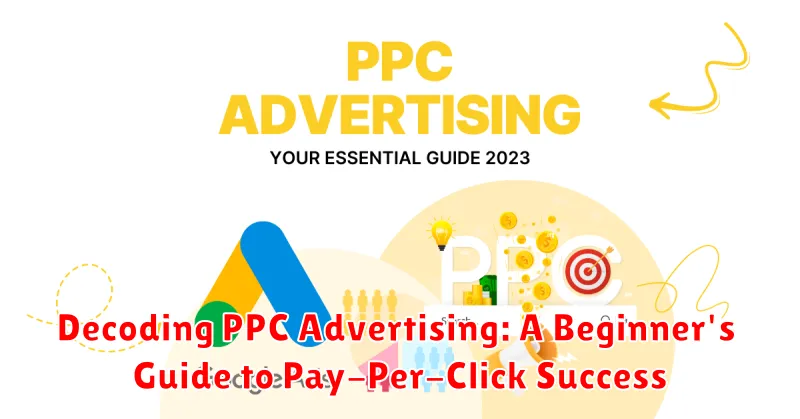Embarking on a digital marketing journey? Pay-per-click (PPC) advertising offers a powerful avenue to reach your target audience directly and efficiently. This comprehensive beginner’s guide to PPC advertising will demystify the complexities of paid search, equipping you with the foundational knowledge to launch successful campaigns and achieve your marketing objectives. From understanding the core principles of PPC and choosing the right platform to crafting compelling ad copy and optimizing for conversions, this guide will navigate you through every step of the PPC process.
PPC advertising, a cornerstone of modern digital marketing strategies, allows businesses to pay for prominent placement on search engine results pages (SERPs) and other online platforms. Understanding how PPC works is crucial for maximizing your return on investment (ROI). This guide will delve into the mechanics of PPC bidding, keyword research, ad creation, and campaign management, providing actionable insights to drive targeted traffic and achieve measurable results. Whether you’re aiming to increase brand awareness, generate leads, or boost sales, mastering PPC is essential for online success in today’s competitive landscape.
What is PPC Advertising and How Does it Work?
Pay-Per-Click (PPC) advertising is a digital marketing model where advertisers pay a fee each time one of their ads is clicked. Essentially, it’s a way of buying visits to your website, rather than attempting to “earn” those visits organically.
Imagine an auction. You bid on keywords relevant to your business. When a user searches for those keywords on a search engine, the search engine runs an auction. The highest bidder, taking into account factors like ad quality and relevance, often gets the top ad placement.
If a user clicks your ad, you pay the search engine the fee you bid. This “click” directs the user to your website, where you have the opportunity to convert them into a customer. Conversion could mean making a purchase, signing up for a newsletter, or filling out a contact form. The ultimate goal is to achieve a positive return on investment (ROI), where the value gained from conversions exceeds the advertising cost.
Exploring Different PPC Platforms: Google Ads, Bing Ads, and More
Venturing into the world of PPC advertising involves selecting the right platform for your business. Several key players dominate the landscape, each offering unique advantages.
Google Ads
Google Ads reigns supreme as the most popular PPC platform. Its massive reach, powered by Google’s search engine dominance, provides access to a vast audience. This platform boasts a wide range of targeting options, allowing for granular control over ad delivery.
Bing Ads
Bing Ads, while smaller than Google Ads, offers a distinct advantage: a potentially less competitive and more affordable landscape. It caters to a slightly different demographic, sometimes yielding higher conversion rates for specific industries.
Social Media Advertising (PPC)
Beyond search engines, social media platforms like Facebook, Instagram, and LinkedIn offer robust PPC advertising options. These platforms allow targeting based on demographics, interests, and behaviors, enabling highly personalized campaigns.
Choosing the right platform depends on your target audience, budget, and campaign objectives. Exploring and experimenting with different platforms is crucial for optimizing your PPC strategy.
Setting Up Your First PPC Campaign: A Step-by-Step Guide
Launching your initial PPC campaign can feel daunting, but a structured approach simplifies the process. Follow these essential steps to get started:
1. Define Your Campaign Goal.
What do you want to achieve with this campaign? Increased brand awareness, driving website traffic, or generating leads? A clear objective guides your strategy.
2. Choose Your Target Audience.
Precise targeting is crucial. Define your ideal customer based on demographics, interests, and online behavior. This ensures your ads reach the right people.
3. Set Your Budget and Bidding Strategy.
Determine your daily or monthly spending limit. Experiment with different bidding strategies, such as manual bidding for greater control or automated bidding for simplified management.
4. Select Relevant Keywords.
Choose keywords that align with your target audience’s search terms. Use a mix of broad match, phrase match, and exact match keywords to refine your reach.
5. Craft Compelling Ad Copy.
Write concise and persuasive ad copy that highlights the benefits of your product or service. Include a clear call to action to encourage clicks.
Understanding Keyword Research and Targeting for PPC

Keyword research is the foundation of a successful PPC campaign. It involves identifying the terms your potential customers use when searching for products or services like yours. Effective keyword research helps you target the right audience, maximizing your return on investment.
Targeting allows you to refine your audience further. Beyond keywords, you can target based on demographics, location, interests, and even the devices they use. This ensures your ads are shown to the most relevant users, increasing the likelihood of clicks and conversions.
There are various keyword match types that control how closely your ads match user searches. These include broad match, phrase match, exact match, and negative keywords. Understanding these match types is crucial for controlling your ad spend and reaching the right audience.
Tools like keyword planners can help you discover relevant keywords, analyze search volume, and understand competition. These tools provide valuable data to inform your keyword strategy and optimize your campaigns.
Crafting Compelling Ad Copy that Converts
Writing effective PPC ad copy is crucial for attracting clicks and driving conversions. Relevance is key; your ad copy must directly address the user’s search query. Clearly highlight the benefits of your product or service and how it solves their problem.
Use a strong call to action that encourages immediate engagement. Phrases like “Shop Now,” “Learn More,” or “Get a Free Quote” create a sense of urgency and guide users towards the desired action.
Keywords play a vital role in ad copy. Incorporate relevant keywords naturally within the text, but avoid keyword stuffing. Focus on creating a compelling and readable message that resonates with your target audience.
A/B testing is essential for optimizing ad copy performance. Experiment with different headlines, descriptions, and calls to action to determine which variations yield the highest click-through and conversion rates. Continuously analyze and refine your ad copy based on performance data.
Optimizing Your PPC Campaigns for Maximum ROI
Optimizing your Pay-Per-Click (PPC) campaigns is crucial for achieving a strong return on investment (ROI). Effective optimization involves continually refining your campaigns to improve their performance and efficiency.
A key aspect of optimization is keyword refinement. Regularly analyze your keyword performance and identify high-performing keywords. Focus your budget on these keywords and eliminate or pause those that are not generating conversions.
Bid management is another critical component. Adjust your bids strategically based on keyword performance, competition, and time of day. Consider using automated bidding strategies to streamline this process.
Ad copy optimization plays a significant role in attracting clicks and driving conversions. Test different ad variations to determine which messaging resonates most effectively with your target audience. Clearly highlight your unique selling propositions and include a compelling call to action.
Finally, landing page optimization is essential for converting clicks into customers. Ensure your landing pages are relevant to your ad copy and offer a seamless user experience. A clear and concise call to action is crucial for driving conversions.
Tracking and Analyzing Your PPC Performance
Tracking and analyzing your PPC campaigns is crucial for maximizing your return on investment. Without data, you’re essentially flying blind. This involves monitoring key metrics and making data-driven adjustments.
Start by setting up conversion tracking. This allows you to see which keywords and ads are leading to desired actions, such as purchases or sign-ups. Key Performance Indicators (KPIs) like click-through rate (CTR), conversion rate, and cost per conversion offer valuable insights into campaign effectiveness.
Regularly review your campaign data within your chosen advertising platform. Analyze which keywords are performing well and which are underperforming. Identify trends and patterns to understand user behavior. Based on your analysis, adjust bids, refine targeting, and optimize ad copy to improve overall performance and achieve your campaign goals.
Common PPC Mistakes and How to Avoid Them

Even with careful planning, PPC campaigns can fall short of expectations due to common mistakes. Understanding these pitfalls is crucial for maximizing your return on investment.
One frequent error is poor keyword research. Targeting overly broad keywords can lead to irrelevant clicks and wasted budget. Solution: Conduct thorough keyword research using tools like keyword planners, focusing on specific, long-tail keywords relevant to your target audience.
Another common mistake is neglecting negative keywords. These are terms you don’t want your ads to show for. Solution: Regularly review search term reports and add irrelevant terms as negative keywords to refine targeting and reduce wasted spend.
Ignoring ad copy optimization is also detrimental. Generic ad copy fails to capture attention and drive clicks. Solution: A/B test different ad variations with compelling headlines and clear calls to action to improve click-through rates.
Finally, neglecting landing page optimization can sabotage your campaign. If users click your ad but land on an irrelevant or poorly designed page, they’ll quickly leave. Solution: Ensure your landing pages are relevant to your ad copy, offer a seamless user experience, and have a clear conversion path.
Advanced PPC Strategies for Experienced Marketers
Once you’ve mastered the basics of PPC, exploring advanced strategies can significantly enhance campaign performance and ROI. These techniques require a deeper understanding of campaign data and a willingness to experiment.
Dynamic Keyword Insertion
Dynamic Keyword Insertion (DKI) dynamically updates your ad copy to include the user’s search query. This creates highly relevant ads, improving click-through rates. However, careful implementation is crucial to avoid irrelevant insertions.
RLSA (Remarketing Lists for Search Ads)
RLSA allows you to tailor bids and ad copy for users who have previously interacted with your website. This strategy lets you re-engage potential customers with personalized messaging, boosting conversion rates.
Automated Bidding Strategies
While manual bidding offers granular control, automated bidding leverages machine learning to optimize bids for conversions or other key metrics. This frees up time for strategic planning and analysis.
A/B Testing Ad Copy and Landing Pages
Continuously testing different ad copy variations and landing page elements is essential for optimization. A/B testing provides data-driven insights into what resonates best with your target audience.

